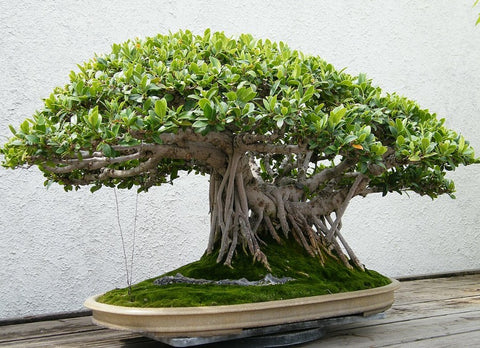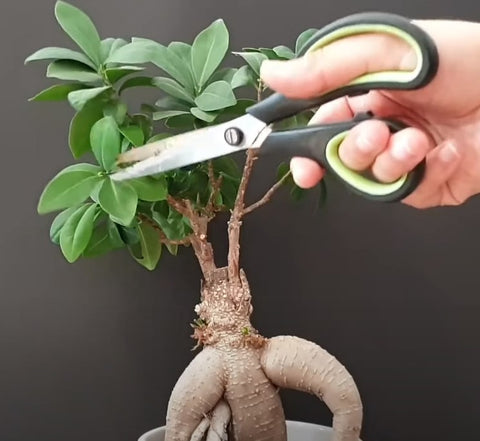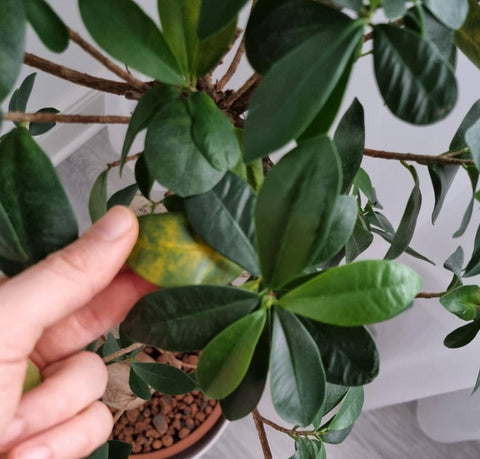Ficus Ginseng Bonsai Care: Essential Tips for Healthy Growth
In the world of indoor gardening, the Ficus Ginseng, scientifically known as Ficus Microcarpa, stands out as an intriguing and visually captivating species. With its unique bonsai-like appearance and reputation for resilience, many plant enthusiasts are drawn to it. However, questions often arise about its care requirements.
In this comprehensive guide, we delve into the world of Ficus Ginseng care, exploring whether these charming air-purifying plants are truly as hard to care for as some might think.
All About Ficus Ginseng Bonsai

Ficus Ginseng Bonsai, scientifically known as Ficus Microcarpa, is a compact ficus plant variety that belongs to the Moraceae family and hails from Southeast Asia. Renowned for its captivating bonsai-like appearance, this miniature tree features intricate aerial roots and glossy green leaves.
Despite its ornate appearance, caring for the Ficus Ginseng is relatively straightforward, making it suitable for both novice and experienced plant enthusiasts alike. With proper care, it can thrive indoors as a stunning decorative piece or as an outdoor accent in mild climates. As for its hardiness, it typically thrives in USDA hardiness zones 9 to 11.
What Does Ficus Ginseng Symbolize?
Symbolically, the Ficus Ginseng represents resilience, strength, and longevity. In Feng Shui, it is believed to bring prosperity, abundance, and positive energy into the home or workplace.
Its robust and enduring nature aligns with the principles of stability and growth, making it a favored choice for those seeking to cultivate harmony and balance in their surroundings.
Ficus Microcarpa Ginseng Care: The Complete Guide

In this comprehensive guide, we delve into the care essentials for Ficus Microcarpa Ginseng, offering expert advice and practical tips to ensure the thriving health of these captivating bonsai trees.
Ficus Ginseng: Soil, Fertilizer, and Repotting
Proper soil composition, fertilization, and timely repotting are crucial aspects of Ficus Ginseng care for optimal growth and longevity. In this section, we’ll explore the essential considerations and best practices for maintaining soil health, providing adequate nutrients, and managing the repotting regimen of your Ficus Ginseng bonsai.
What Is the Best Soil for Ginseng Ficus?
Ficus microcarpa has a reputation for being able to thrive in substandard soil, however, that doesn’t mean you shouldn’t take good care of it. The ideal soil has proper drainage as this stops the roots from being constantly wet. A good option is a combination of peat moss, perlite, and regular potting soil. This mixture provides adequate drainage while retaining sufficient moisture for the plant's needs.
What Is the Best Fertilizer for Ginseng Ficus?
To ensure optimal growth and health, providing your Ficus microcarpa ‘Ginseng’ with regular fertilization is important. The plant's growing season is from spring to early fall and this is when you should fertilize the plant. Feed your ficus bonsai tree every two weeks using a balanced, water-soluble fertilizer, diluted according to the manufacturer’s instructions. During the winter months, you can stop giving your plant fertilizer as this is its period of dormancy.
When Should I Repot Ficus Ginseng?
If you take good care of your Ficus Ginseng, it will eventually need repotting. Typically, this should be every two to three years, or when the plant becomes root-bound. Choose a pot that’s slightly larger than the current one and fill it with a well-draining soil mix. Gently remove it from its current pot, taking care not to damage the roots. Loosen the roots slightly before placing the plant in a new pot and ensuring it’s centered. Fill the remaining space with soil, gently firming it around the roots. After repotting, always water thoroughly to help the soil settle.
Ginseng Ficus: Watering and Light Requirements

Maintaining proper watering and ensuring adequate light exposure are essential for the health and vitality of your Ginseng Ficus bonsai. In this section, we’ll delve into the specific watering and light requirements to ensure optimal growth and thriving conditions for your beloved plant.
How Much Water Does a Ficus Ginseng Bonsai Need?
To water a Ginseng Ficus bonsai, aim for 1/3 of a cup of water to flow through the tree and pour directly on the topsoil. Water the Ficus only when the surface of the soil is really dry. You should only water it once or twice a week at most. In the summer, you may need to water it a bit more, especially if it’s outdoors. Ficus Ginseng doesn’t like standing water, so empty the saucer after having watered the plant.
Does Bonsai Ficus Ginseng Need Sunlight?
Ficus Ginseng requires adequate light for healthy growth. If your plant is indoors, place it on a windowsill where it can receive bright, indirect sunlight. During the summer, if you take your bonsai outdoors on the porch, choose a spot with plenty of sunlight as it will not tolerate shade very well. Opt for filtered or diffused sunlight as direct sunlight will scorch the leaves and harm the plant.
How Much Light Does a Ginseng Ficus Need?
Ficus Ginseng will be its happiest if it receives at least 6 hours of bright sunlight daily. It may tolerate low light but ideally, the tree should receive lots of bright, indirect light for optimal growth.
Ficus Ginseng Bonsai: Temperature and Humidity
Ensuring the right temperature and humidity levels is crucial for the well-being of your Ficus Ginseng bonsai. Keep on reading, as, we’ll explore the optimal conditions required to maintain the health and vitality of your bonsai. Note that the plant thrives best in warm regions typically found in Hardy Zones 10-12.
What Temperature Is Good for Ginseng Bonsai?
The ideal temperature range for growing a Ginseng Ficus bonsai is between 60°F (15°C) and 75°F (24°C). Consistency is key, especially when keeping your bonsai indoors. It’s important to protect your plant from extreme temperature fluctuations and drafts, as they can be detrimental to its health. Ginseng do not thrive in colder conditions and are not frost-hardy. It can be brought outside once temperatures are consistently above 60 F.
Does Ficus Ginseng Like Humidity?
Ficus Ginseng’s sweet spot is between 60-75% relative humidity, mirroring its native tropical environment. You can keep an eye on humidity levels using a hygrometer placed near your plant. Should the numbers stray from the sweet spot, adjust the environment accordingly.
Ficus Ginseng: Pruning

Regular pruning is essential for maintaining the shape and health of your Ficus Ginseng bonsai. It's best to prune during the plant's active growing season, in spring and summer, to encourage new growth and maintain its desired form. Avoid heavy pruning during the dormant winter months to prevent stress on the plant.
Should I Prune Ficus Ginseng?
Ficus microcarpa is a fast-growing tree that requires a medium amount of pruning to maintain. If you leave it to its own devices, it can quickly produce off-shoots and has even been known to grow as an epiphyte on other trees. This means you should undertake pruning as part of its regular maintenance.
How Do I Keep My Ficus Ginseng Small?
If you want to keep your Ficus Ginseng small, you’ll have to prune it regularly. Snip new shoots off as they appear to preserve the original shape of your tree. Cut back leggy branches by always using sterilized scissors. For a bushier look, identify healthy stalks that have at least six leaves and trim back to two leaves.
Ficus Ginseng: Propagation Methods
If you want to expand your Ficus Ginseng bonsai collection or share the plant as a gift to friends and family, propagation is a simple and rewarding process.
The most common method is through stem cuttings. It is an easy process if you follow the steps below:
- Select a healthy, mature stem and make a clean cut below a node.
- Remove any leaves from the lower portion of the cutting and place them in a glass of water or a well-draining potting mix.
- Keep the cutting in a warm, bright location and ensure the soil remains consistently moist. For water propagation, change the water weekly.
- After a few weeks, roots should start to form, indicating successful propagation.
- Once the roots have developed, you can transfer it to a pot of its own.
Another Ficus Ginseng propagation technique is air-layering. This process encourages the growth of new roots on a branch while it’s still attached to the tree.
To perform the task:
- Remove a small section of the branch’s bark, and apply a rooting hormone to stimulate root growth.
- Then, wrap the exposed area with moist sphagnum moss or a similar rooting medium.
- Cover it with plastic to maintain moisture.
- Once roots develop from the wounded area, cut the branch with sharp clean sheers.
- Transplant the rooted baby plant in a pot with fresh soil.
Ginseng Ficus: Common Problems

In this section, we’ll explore some common challenges you may encounter when caring for Ginseng Ficus plants. Understanding and being able to address any problems promptly can help maintain the health and vitality of this gorgeous houseplant.
Why Is My Ficus Ginseng Losing Leaves?
Leaf dropping is commonly a stress response, often due to environmental factors. Water and moisture management are key to preventing leaf loss. Pruning and monitoring help maintain health and reduce leaf shedding.
Why Are My Ficus Ginseng Leaves Turning Yellow?
There are several reasons why your Ficus Ginseng’s leaves are turning yellow. It could be a pest infestation, over or underwatering, seasonal changes, and other environmental factors. In addition, incorrect light exposure, fertilizing mistakes, or transplant shock, post-repotting your plant, can also lead to yellow leaves on your plant. Once you’ve determined the cause, you can take the necessary action to redress the balance.
Ginseng Ficus: Insects and Diseases
Ginseng Ficus plants are susceptible to a few common insect pests and diseases. Spider mites, aphids, and scale insects can infest the foliage causing damage and discoloration. Additionally, fungal diseases, such as root rot and powdery mildew may occur, particularly in conditions of high humidity or overwatering. Regular inspection and prompt treatment with appropriate pesticides or fungicides can help control these issues and maintain the plant’s health.
Ficus Microcarpa Ginseng Care: FAQs
Q: What is the cold tolerance for Ginseng Ficus?
Ginseng Ficus is generally not very cold-tolerant as it is native to warm and tropical regions. It thrives in hardiness zones 10-12, where temperatures typically remain above freezing. Exposure to temperatures below 50°F (10°C) can cause stress and damage to the plant, particularly if prolonged or severe.
Q: How do you save a dying Ginseng Ficus?
There are several steps you can take to help revive a dying Ginseng Ficus:
- Prune dead branches
- Examine the cambium layer
- Prune the roots
- Place in water
- Repot in well-draining soil with good aeration
- Change its location
Q: Is Ficus Ginseng safe for pets?
No, this is a houseplant that’s toxic for pets. Consider growing only pet-friendly plants around your furry friends or keep your Ficus Ginseng out of their reach.
Q: Should I mist my Ginseng Ficus?
Misting your Ficus Ginseng can be beneficial, especially if you want to create a more humid environment for this tropical plant. It also helps remove dust from the leaves, allowing it to breathe and photosynthesize more effectively.
Q: Is Ficus Ginseng a lucky plant?
According to feng shui principles, this plant is considered lucky and symbolizes positive energy and harmony in your living space. Its association with abundance and wealth is reinforced by the fact that it belongs to the fig tree family and can even bear fruit loved by some birds.
Conclusion
Caring for a Ficus Ginseng bonsai requires attention to its specific needs, including proper watering, lighting, and pruning techniques. This way you’ll have a vibrant plant that brings you joy and harmony. Understanding its symbolism and Feng Shui significance also adds depth to its appeal.
Complement your indoor garden with plants like the Snake Plant and ZZ Plant, which share similar care requirements, and enhance the greenery in your space. With diligence and knowledge, your Ficus Ginseng bonsai will thrive, adding beauty and tranquility to your home or office environment.












Leave a comment